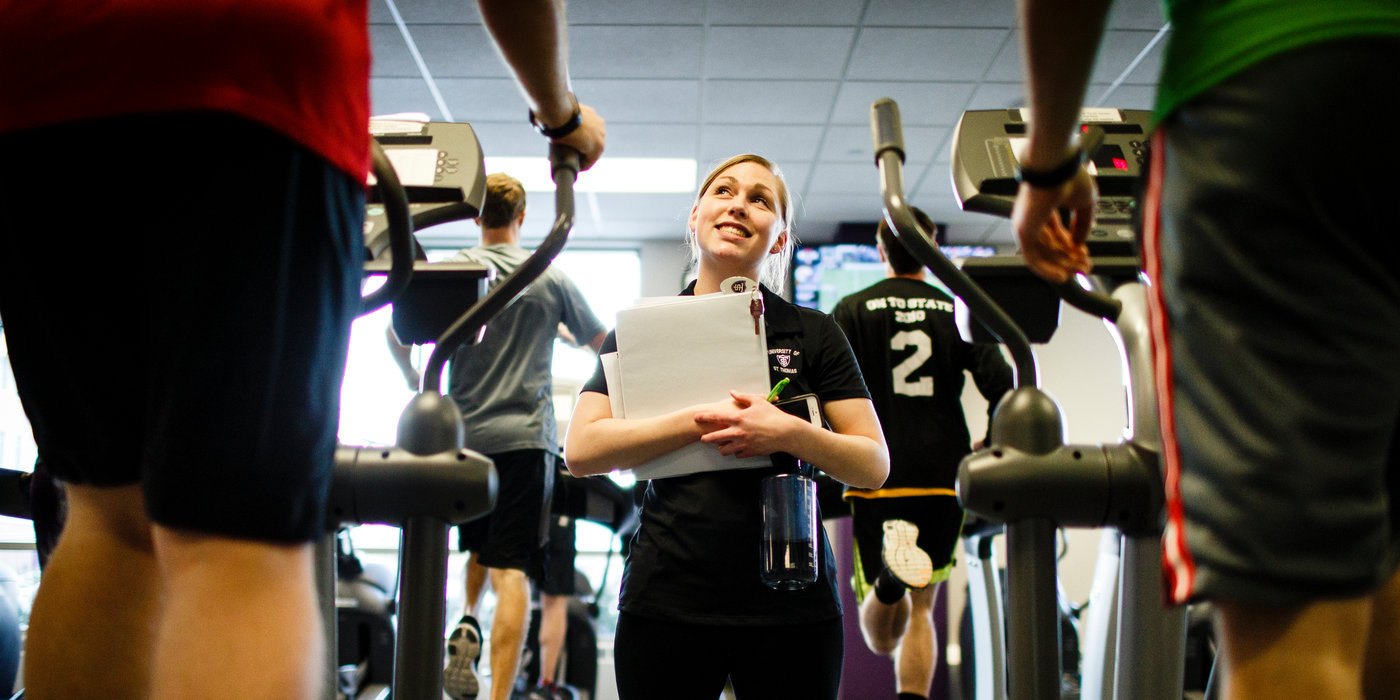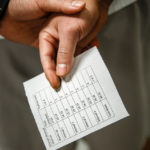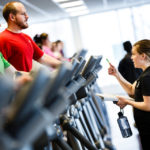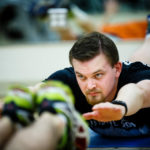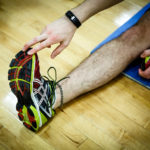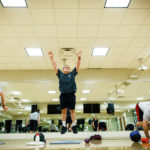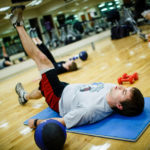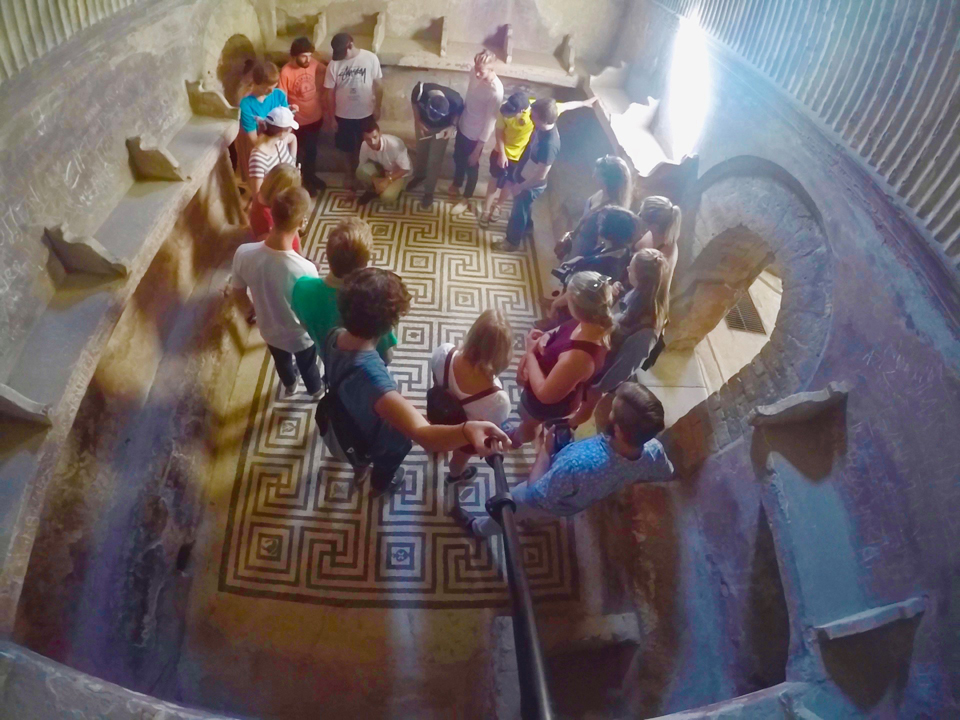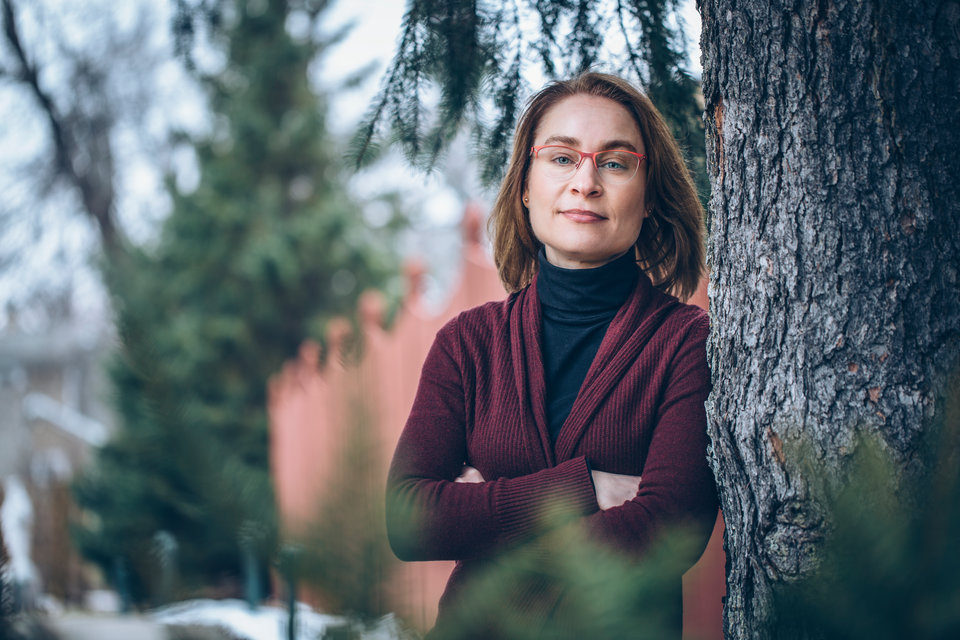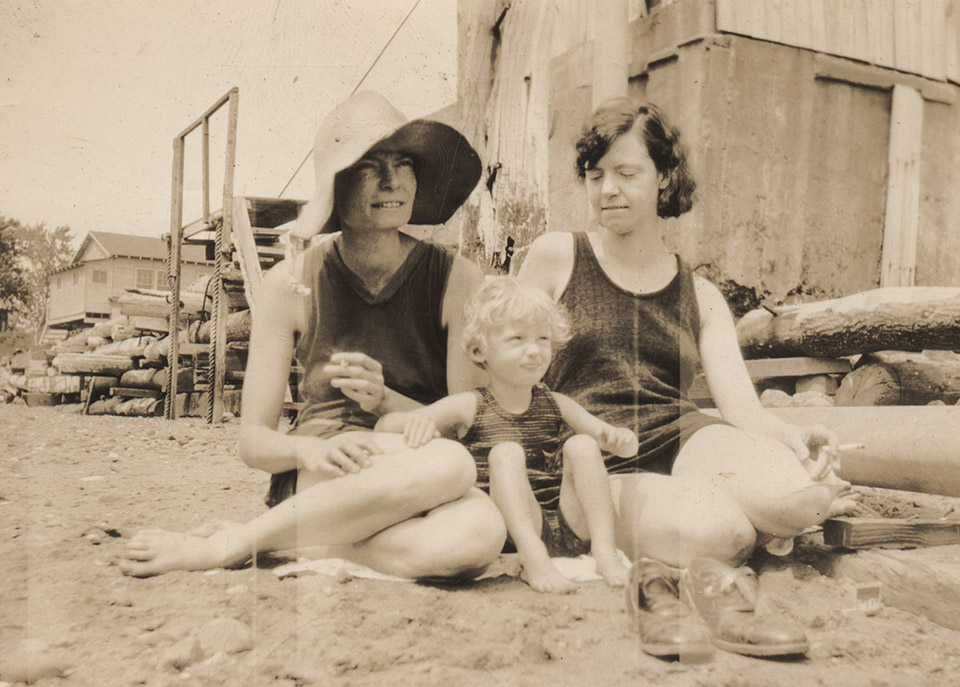It’s 3:34 p.m. on a Thursday, and seniors Sophie Gottsman and Jordan McGowan are the only people in the Anderson Athletic and Recreation Center cardio room not on their way to breaking a sweat. Watch them for a couple of minutes, though, and it’s clear they’re not avoiding work of their own.
The crisp polo shirts they’re wearing help signal that the pair are here for business. A clipboard and pencil add to the picture of professional attention. With a water bottle dangling from her left hand, Gottsman walks along a line of four men see-sawing their arms and legs on elliptical machines.
“How did those last two sets of intervals feel?” she asks one, cocking her head to the side and flashing a half smile that hints at the unsaid follow-up: I know they were tough.
The response – despite coming mid-workout – is a positive one: “It felt good. Better than it would have a month ago.”
That type of exchange will play out several more times in the next half-hour before Gottsman and McGowan head down the hall to an empty aerobics room. A sweaty crew of men will trail behind them like ducks in a row.
The men are a dozen students at the Saint Paul Seminary School of Divinity, St. Thomas’ graduate seminary program located on the south campus; Gottsman and McGowan are undergraduate students in the Health and Human Performance Department’s Exercise Science 432 class. Together, the seminarians and HHP students are part of the Fit For Ministry program, a first-of-its-kind experiment at St. Thomas offering seminarians a comprehensive health and training experience and HHP students the opportunity to design, implement and lead real training. At first glance, the two groups at St. Thomas are quite different, yet together they have created something incredible: a semester-long illustration of collaboration, education, friendship and growth.
‘The program just exploded’
Catholic priestly training includes four pillars of formation: intellectual, spiritual, pastoral and human. A large part of the human pillar is being physically healthy, and the lack of training in physical wellness at the Saint Paul Seminary seemed like a pressing need to Father Allen Kuss. Kuss was a military priest for 20 years before coming to the Saint Paul Seminary in 2011, so some of the lack of attention to physical fitness and diet at his new civilian posting was obvious to him from the beginning.
“I saw it right away,” Kuss says. “But I didn’t know what to do about it.”
He found his answer last summer across Cretin and Summit avenues on north campus at the AARC, where he approached HHP Department faculty about putting together some kind of training program for the seminary.
“He described it very beautifully and it resonated with us. He sees their health and wellness as an integral part of their spiritual health,” HHP professor Lesley Scibora says. “We just said, ‘Absolutely.’”
HHP department chair Bridget Duoos adds, “He knows these individuals are preparing for a very stressful career and would need to deal with their health as they moved along. This was a great opportunity for us to say, ‘Yes, we have the knowledge and skill to help you out.’”
Soon after offering to work with Kuss and the seminary, the HHP faculty learned they were going to have more of a challenge than they had expected.
“We invited the seminarians to participate thinking we would maybe get 20, 25,” Scibora says. “We ended up getting 59. The program just exploded.”
That meant some major design shifts in how HHP students and faculty would handle the project. Each student in the Exercise Science 432 class took on about four seminarians instead of one or two. “Everyone was a little nervous about that at first,” senior HHP student Alex Altenbernd says. HHP also pulled in students enrolled in a bio-mechanics class to do gait analysis for each seminarian and asked St. Thomas’ health services to do blood profiles of the seminarians.
“It really has been a huge collaborative effort,” says adjunct professor Angela Effertz, who teaches Exercise Science 432 and took the lead in organizing the student training portion of the project.
Initial testing came at the outset of the fall semester, giving the seminarians and their trainers a baseline to work from for the next few months. It also provided data for an ongoing research project that will show the results of, by all accounts, a first-of-its-kind experiment anywhere with seminarians.
The study – titled simply, “Fit For Ministry” – has been approved by the university’s Institutional Review Board for research involving human subjects. It will use data from both the pre- and post-assessments to gauge “how a student-led fitness program impacts cardiovascular, strength and other fitness aspects for a group of seminarians,” Scibora says. That data will be evaluated throughout the spring and help inform the feasibility of continuing similar studies both at and outside St. Thomas.
“It’s not every day you get almost 60 people from one group willing to take part in a semester-long study like this,” Scibora says. “They’re very representative of the overall population, which is great for a study to make a valuable scientific contribution.”
Growing students
Once the baseline numbers were in place for each seminarian, the work on improving them began. Under the guidance of Effertz, HHP students designed weekly workout routines that helped move each seminarian toward his individual health goal. For some, the goal was to lose weight. For others, it was to learn more workout routines they could use in the future. For others, it was to gain a better understanding of an overall view of their health.
“They’re all varied and it can be hard to create a workout that suits everyone,” Gottsman says. “There are a few guys who ran the last Twin Cities Marathon next to some guys who are obese. Trying to accommodate all that is a skill.”
“Right away it was kind of overwhelming,” Altenbernd says. “You’re kind of playing it by ear and seeing how each day went.”
Effertz, Scibora and Duoos all described seeing – over the course of the first few weeks and throughout the semester – the HHP students embracing this professional role and its complex demands.
“I’ve really seen that come through in them. It’s fascinating watching them and how it has forced them to embrace this as a clinical situation as opposed to just a lab class,” Effertz says. “We teach, teach, teach all this stuff in the classroom, and then when it comes to the application it’s, ‘How do we connect it? How do we really take our students’ brilliance so they can use it to talk to someone else about what’s going on in their body?’ That’s what they’re doing with Fit For Ministry.”
Scibora seconds that view. “It was fun to see how much they grew in terms of professional development, skill development and their ability to interact in different situations with people they hadn’t met before,” she says. “It was very real world for them. They took it seriously and stepped up.”
The students also saw their own growth.
“My first day, I was so nervous. I was scared of my verbiage, how to approach (the seminarians) in a personal matter,” Gottsman says. “Once we got in there ... we fell into the role and I wasn’t nervous. It has become very natural to be able to do this.”
Part of the reason Fit For Ministry could happen, Effertz says, is because HHP faculty already emphasize students’ active learning, rather than acquiring knowledge solely through lecture. Because hands-on learning has long been a benchmark of the department, giving students the responsibilities required for this project wasn’t exactly plotting a new course.
“This whole department excels in that area, giving students the opportunity to do things realistically,” Effertz says. “That’s what this program is built upon. It’s rare throughout the exercise science discipline. This is a very student-driven department ... and what we saw in FFM is a representation of what other faculty do here in all of their classes. It’s so amazing. And the students really appreciate and recognize that.”
HHP students and faculty said a huge part of the program’s success was the buy-in from the seminarians.
“This was much needed. There hadn’t been much talk about physical fitness at the seminary because we have so much else to focus on,” seminarian Barry Reuwsaat says. “But it’s so important. It helps us relieve stress, work with mental clarity and just be healthier. I’m really thankful Father Kuss got this rolling.”
Kuss also secured the funding to equip every one of the participants with fitness trackers, which generated friendly competition as the seminarians counted their steps. More importantly, the program created a renewed focus on the importance of these men developing healthy habits they can carry forward when they are on their own as church leaders.
“You can’t just live a healthy lifestyle if you have no knowledge to draw from. This is setting us up for the future,” Reuwsaat says. “The connection of the body and soul, you can’t disconnect the two. We’re helping that (connection).”
Crossing campus
Duoos says HHP students were pleased to help foster that connection, too. “Our students have had this impact on a group who will go out into the community and will have an opportunity to make huge differences from their leadership positions. Sort of like teaching, you don’t realize how wide your net is cast when you train someone here who then goes out and influences a whole different group of people.”
Conversations have also allowed HHP students to learn about the seminary, an area of their university they otherwise might have never known, and about priests-in-training who showcase a high level of discipline and determination.
“As we are able to teach and guide the seminarians, I know many of the student trainers have learned a lot from them,” senior Sam Sutton says. “They show up to each training session with a positive attitude. Their schedules are very busy and each day is most likely not their best day, but they always show up motivated to work out.
“They not only want to learn about exercise, nutrition and other lifestyle choices, but they are genuinely interested in learning about us as people,” he adds. “This helped me better see the importance of relationships you make with others around you, no matter what type.”
Seminarians also benefited from getting to know the HHP students. “I think initially we were maybe a little scared of them and they were maybe a little scared of us. Some of these guys are on the football team, in great shape, and we’re seminarians from south campus,” seminarian TJ McKenzie says. “They’re hopefully seeing we’re not weird or anything, and we’re seeing them as people who have a lot to offer. We can learn a lot from each other.”
As St. Thomas continues to emphasize cross-collaboration between departments and groups across campus, Fit For Ministry has proven to be a showcase of what’s possible when two seemingly different groups of people come together.
“It’s a great example of how different disciplines can find a common language. In this case that common language is health and fitness, and a way to bring these seemingly disparate groups together to learn from each other,” Scibora says. “Our students learn from the seminarians and see the way they interact with one another, and the way they approach life and their health. The seminarians were able to see a completely different side of how they might view health and fitness. They came together on these topics and had a really interesting dialogue.”
Still climbing
Back in the aerobics room, Gottsman and McGowan lay down their workout mats as the seminarians spread out in a curving row across from them.
“We’re going to run through some of the same core exercises we’ve done in the past,” Gottsman says. “Let’s start with the bridge.”
Ten minutes later a fresh sweat gleams on the foreheads of most everyone in the room. Aloe Blac’s voice pumps over the speakers: “I’m the man, I’m the man, I’m the man, yes I am, yes I am, yes I am!”
“I can really feel that in my lower abs,” one seminarian admits as the seconds crawl by and he maintains a plank pose.
“Make sure you’re continuing to breathe and engaging your core,” Gottsman reminds them from her own planked position.
At the end of the session most of the seminarians linger, visiting with one another and their trainers before heading off in ones and twos to the locker room. It’s the final workout before Thanksgiving break and there are large meals all over the country to look forward to, after dietary indulgences during the fall have been much less common for the seminarians in Fit For Ministry.
Two months later Gottsman sits outside T’s in the Anderson Student Center, thinking back through that pre-holiday session and so many others that made up a semester’s worth of dedication and payoff.
“Saying goodbye to the seminarians was bittersweet. It was a lot of work off my shoulders, but it was sad because I enjoyed them so much,” she says. “It was a really, really good experience and an awesome opportunity. I’ve heard from other students that have taken this class last year and it was, ‘Wow, I’m bummed I didn’t get to do this.’”
If all goes well more students will get to take part in the future: HHP faculty and Kuss met after the semester to break down how things went and everyone came away hoping they can put together a similar program again.
“I asked Father Kuss to give me a sense on a continuum of how were your expectations met, or not met. He said, ‘Far exceeded,’” Scibora says. “That just spoke volumes to me. I thought, ‘OK, wow, this was really, really fantastic.’ He was just really pleased with how the men responded, we were so pleased with how our students stepped up to this professional challenge, and it all came together and exceeded expectations. It was a home run.”
Duoos notes, “To be able to see the pride (the HHP students) took in what they were doing, there was just so much student growth. They learned so much and to discover that what they learn can really make a difference, that’s such an important takeaway for them. They’re so proud of what they’re doing.”
There’s plenty to be proud of already and – with nearly 60 seminarians and seminary faculty ready to use what they’ve learned on a daily basis – there’s almost certainly going to be more to be proud of. Thousands of miles from the AARC in January, McKenzie and his peers were in the midst of proving that in Rome.
“I’m still wearing my Garmin Vivofit (fitness tracker) and I’m averaging 15 miles a day, but I’m not too sore because Fit For Ministry got me ready for it,” McKenzie says in an email. “Yesterday we climbed to the top of St. Peter’s (Basilica) and we didn’t choose to take the elevator since we wanted more steps in.”
There are 320 steps to the top of St. Peter’s Basilica. And it’s a good bet the members of the Fit For Ministry program won’t stop their climbing there.
Read more from CAS Spotlight.
